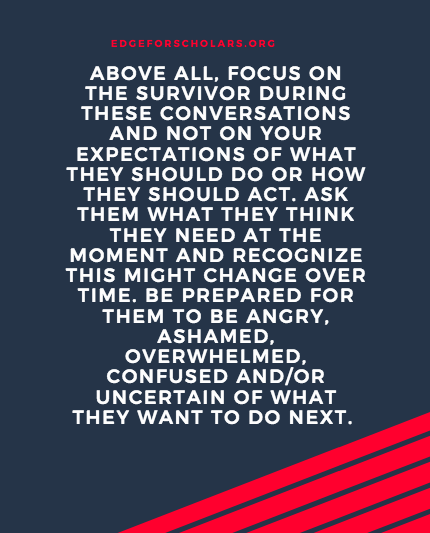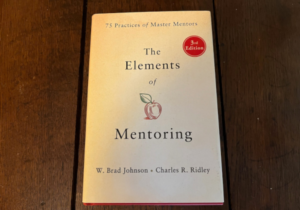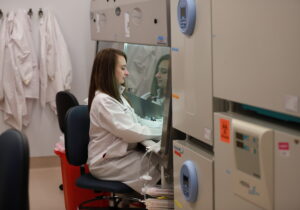A Beginner’s Guide for Addressing Sexual Harassment in Academia
Last fall, I was having a conversation with several male scientists on Twitter who were surprised and dismayed at the number of women identifying themselves as having experienced sexual harassment and assault in the wake of the #metoo movement. It was clear that these men were deeply troubled by the scale of sexual harassment and assault in STEM and wanted to know how they could help. One thing that I found myself repeating over and over again was that, yes, providing individual advocacy and support was an important part of the response, but these often relied on informal networks that not all women might have access to. Instead, this personal support needed to be complemented and strengthened by changes in cultural, structural, and institutional responses to sexual harassment and assault so that ALL women, even those without easy access to advocates and allies, were provided with support, safety and most importantly options. I decided to outline how personal support for survivors might go hand in hand with addressing cultural, structural and institutional responses to harassment and assault in a Twitter thread here. For those not on Twitter or who don’t appreciate threads, I’ve rewritten and updated some of the information in this blog post.

Identify yourself as someone who believes the experiences of women and other groups underrepresented in STEM: First, men must appreciate that women, and other groups underrepresented in STEM, are often considering their safety in places where most men rarely have to, including at work. Further, we’ve received many messages, both direct and indirect, that perceived threats to our safety are often not believed. Therefore, a major cultural shift that needs to happen is that people who want to prevent and limit sexual harassment and assault need to signal that they will believe the experiences of women and other people underrepresented in STEM. This could include: a blog post (Melissa Wilson Sayres has a good one here), the inclusion of an anti-harassment policy on your lab website or mission statement for your lab (Clement Chow’s lab’s website has a good one here) or a conversation with every member of your lab to let them know that their safety is paramount and that harassment will not be tolerated. If there are formal or informal gatherings, such as overnight retreats, conferences or beer hours where sexual harassment or assault might happen, let trainees know beforehand that you are someone they can talk to if they experience or observe sexual assault or harassment.
Familiarize yourself with how sexual assault and harassment are handled at your institution: Being able to initiate and have these conversations requires that you be familiar with the sexual harassment and assault policies at your institution. Almost all institutions have Title IX office tasked with addressing sexual harassment and assault. Keep in mind that Title IX offices can be more focused on protecting institutions rather than survivors of harassment (see these pieces by The Edge for Scholars’ Fighty Squirrel: Winning a Title IX Case and Gaslighting: How Universities Use Their Title IX Office to Crush Complaints). Given that Title IX investigations may not necessarily benefit survivors, find out if you are a mandatory reporter (as a professor, as a PI, as a TA). If you are, also find out about confidential services, at your institution or elsewhere, for survivors of sexual harassment and assault and be prepared to provide them so that survivors keep all of their options open, even if that means not reporting. For example, find out if your institution is partnered with Callisto to provide this confidential possibility to survivors.
Being familiar with this information will help when you have conversations with those who have survived sexual harassment or assault. Above all, FOCUS ON THE SURVIVOR during these conversations and not on your expectations of what they should do or how they should act. Ask them what they think they need at the moment and recognize this might change over time. Be prepared for them to be angry, ashamed, overwhelmed, confused and/or uncertain of what they want to do next. Your focus should be on the survivor: let them know you believe them and that the harassment or assault was absolutely not their fault. Further, let them know you will support any decision they make and will help them get any additional support they might need.
What institutional changes might be necessary? While signaling that you support survivors and providing this support to survivors, think about what institutional or structural mechanisms might be strengthened at your institution. If your institution is not partnered with Callisto, recommend that they do so. Look at how your institution’s Title IX office HAS handled harassment and assault claims in the past. This might be hard, given they are often confidential, but ask around or do Google searches. Are they still working in the same role? Do they still mentor trainees? Are they being promoted? Have they received additional training or warnings? This will give you a sense of who may be prioritized at your institution and whether you can safely suggest reporting as a viable option. This will also give you something to highlight to your administration as something that may need to be strengthened and/or changed.
 Look at programs at your institution: Are graduate students provided with explicit sexual harassment and assault training? Are faculty?
Look at programs at your institution: Are graduate students provided with explicit sexual harassment and assault training? Are faculty?
Look at hiring at your institution: Find out if you can ask potential hires if they’ve ever been focus of Title IX investigation. Find out if you can ask references the same question. This will prevent the “passing of the trash,” the situation where someone leaves one institution where they harassed or assaulted individuals only to be hired, and endanger women, elsewhere.
Do you know the prevalence of sexual harassment or assault among graduate students? Postdocs? Faculty? Would anonymous surveys better help you understand the scope of the issue and how to best address it institutionally? For example, the #safe13 study by Clancy, Nelson, Rutherford and Hinde demonstrated the scope of sexual harassment and assault in scientific fieldwork settings. And more recent work, #safe2, provided guidance for signaling safety in scientific fieldwork settings. These surveys could also be useful to provide benchmarks to evaluate the success of strategies that are implemented to prevent sexual harassment or assault.
These are all mechanisms that can provide important information about how safe your institution might be and highlight changes that may need to happen to make it safer.
Familiarize yourself with the sexual harassment and assault policies at the scientific conferences you attend: Being involved in STEM often means attending professional conferences and workshops where people may be exposed to sexual harassers. Warn your trainees about any known or suspected harassers that they might interact with at meetings. Let your trainees, BOTH men and women, know what is appropriate behavior at meetings. For example, see this thread by Dr. Clarissa Parker. Find out if the conference has a sexual harassment policy and make sure it, as well as reporting strategies, are publicized at the start of meeting. I like the Gordon Conference’s inappropriate behavior policy, which is announced at the start of meetings. Since safety is paramount, also familiarize yourself with potential anonymous ways for people to report harassment or assault. For example, surveys completed at the end of conferences can let future organizers, as well as sponsoring programs, know that harassment is an issue.
Practice interventions: Whether in your department, at your regular conference, or at an informal gathering, practice intervening as a bystander. Often, when we observe something inappropriate, we freeze, unsure of how to address it. Practice provides a ready response. One strategy, presented by Marissa Lingen on Twitter, was to practice saying “Wow.” A well-placed “wow” can signal that you are not okay with the direction a conversation is taking. If you see an interaction that looks uncomfortable, sketchy or awkward, walk over and join the conversation or introduce yourself to the participants. Afterwards, check in with people who looked uncomfortable and ask if they were okay or felt uncomfortable. Ask if you or anyone else can help. They might want more support or the opportunity to report, anonymously or not. They might simply appreciate you checking in and not want to do anything else. LISTEN TO THEM and what they want. Let them know they are not alone or imagining it. These are also good suggestions here. You might feel uncomfortable or that you are overreacting but this discomfort is worth providing safety and comfort to someone who might feel threatened or unsafe.
Do not reward known sexual harassers or assaulters in your professional circles: Talk to your peers and colleagues about sexual harassment and assault and erode the status that some serial harassers continue to enjoy. Do not collaborate with them. Do not invite them to meetings, to give seminars, etc. Do not invite them to be a PI on a training grant or to participate in a graduate program. Contact NIH and NSF and ask them what they plan to do about grants awarded to institutions with NIH- or NSF-funded PIs under Title IX investigation. For example, the NSF is considering adding a condition to their awards that awardee organizations need to notify NSF within seven days when NSF-funded PIs and co-PIs are being investigated for sexual harassment or assault and have been placed on administrative leave. Ask the NIH whether they are considering a similar condition on their grants. Here are some other suggestions.
Racism is also a major issue in STEM: I haven’t even touched racism, or the intersection between race and gender, here, which is also a major problem in STEM. One major impediment to addressing racism and xenophobia in STEM is the lack of a corresponding office to the Title IX office for civil rights violations. For example, most institutions have a Diversity, Equity and Inclusivity Office but not a Title VI office (as pointed out by Dr. Chanda Prescod-Weinstein on Twitter). However, some of these suggestions could be useful when considering how to address racist comments and behavior in your department, institution or conferences in your field.
Start small, if you need to: This is A LOT, so if this list seems daunting, start small. Pick a few things you feel like you can handle and work up to the more ambitious stuff. Also, if you have additional suggestions, please feel free to leave them in the comments. Only by addressing both personal support for survivors and making institutions more responsive to sexual harassment and assault will we create a truly diverse and inclusive STEM community.






4 Comments
Great post Needhi. I think it’s so important to mirror some of the fast moving conversations that happen on Twitter in blogs. I see how the Twitter community helps us shape our opinions in real time and I love how much thought and truth of those conversations you’ve captured. I also know that for as many allies as we have, there are many fold more people who are working away in their offices unaware that there is a community out there that is suffering, so thank you for your primer on how they can be allies.
[…] de esta lacra y para ponerle coto en cuanto se produzca y los propios científicos (de ambos sexos) se movilizan para ayudar. El abuso de hombres con poder sobre mujeres sin poder se ha tolerado durante demasiado tiempo, y […]
[…] A Beginner’s Guide for Addressing Sexual Harassment […]
[…] https://edgeforscholars.org/a-protocol-for-addressing-sexual-harassment-and-assault/ […]